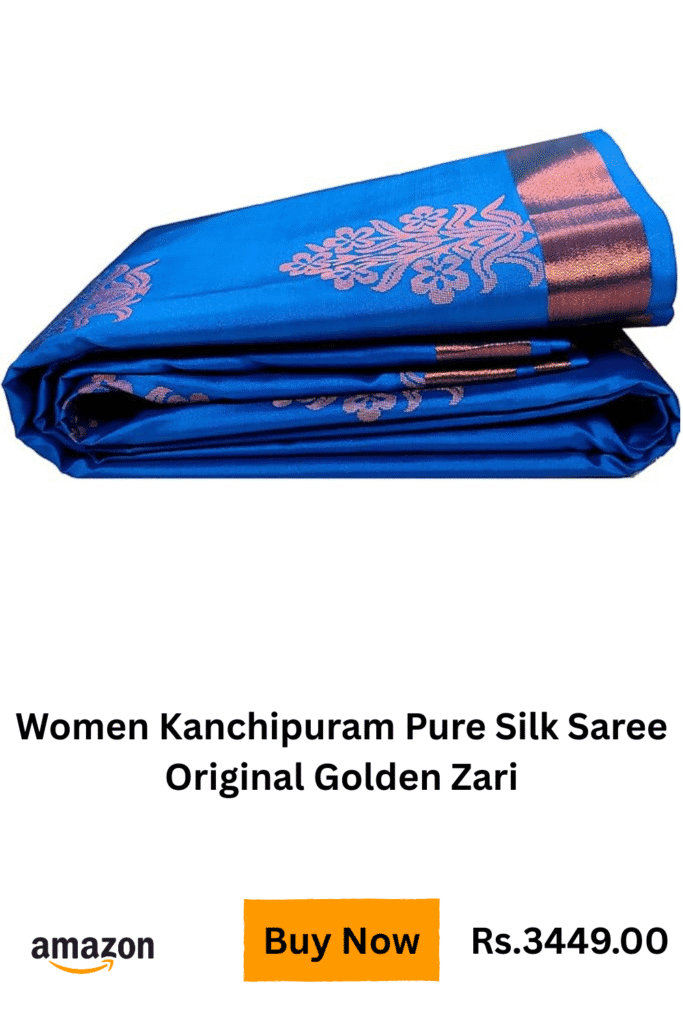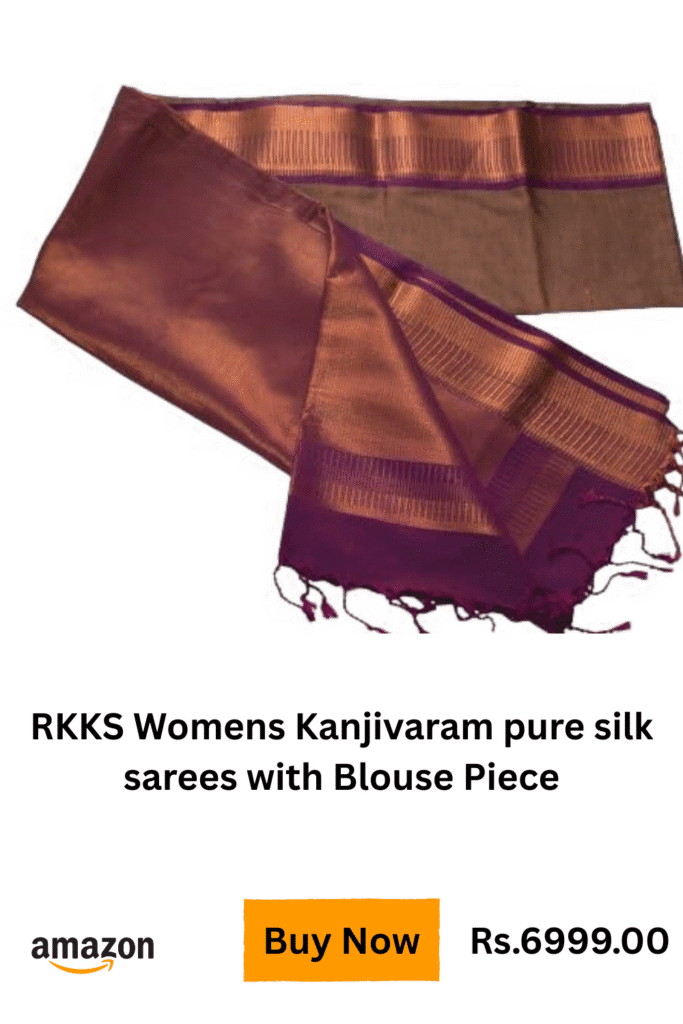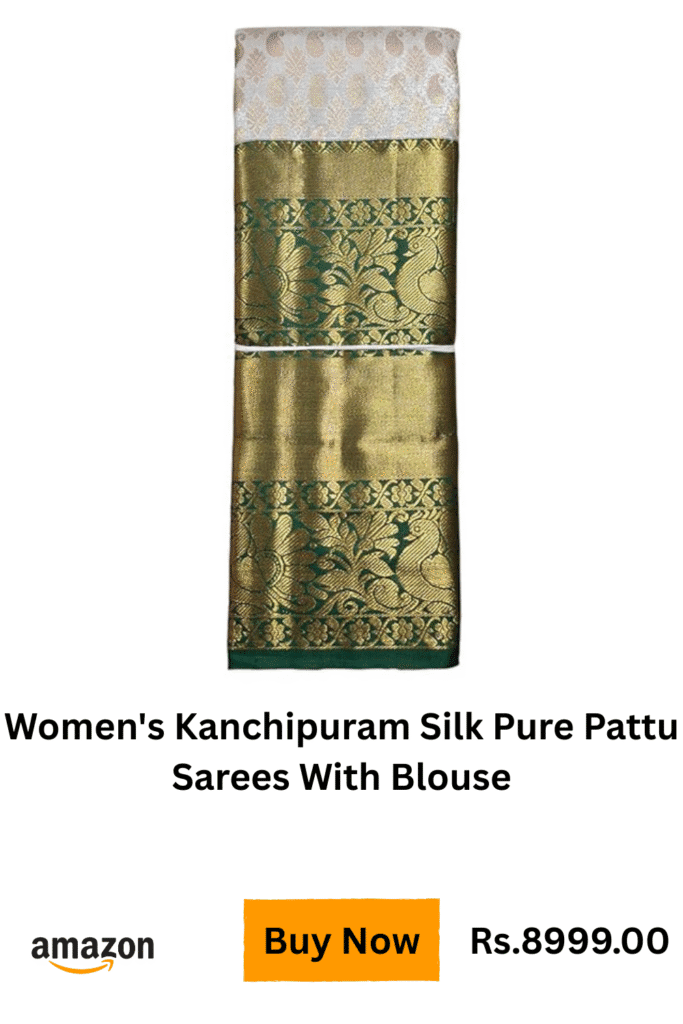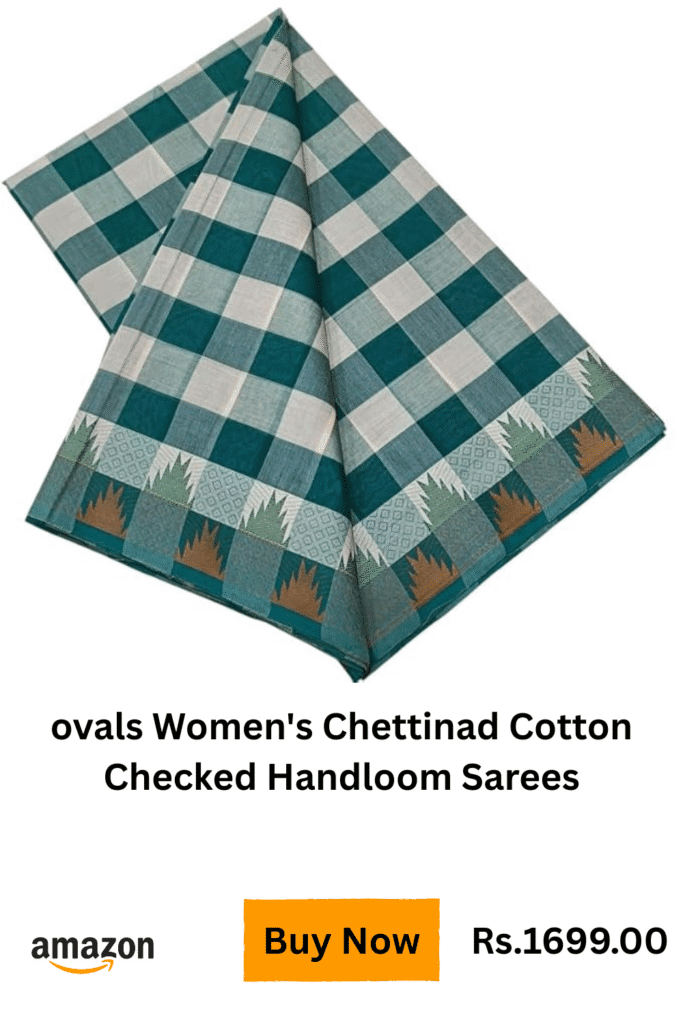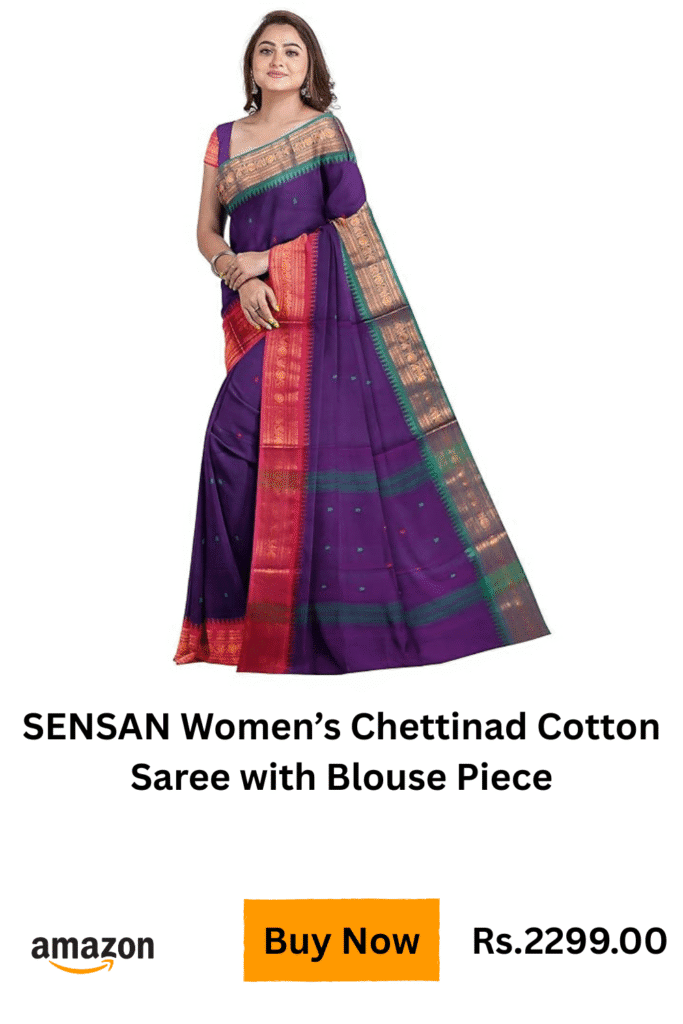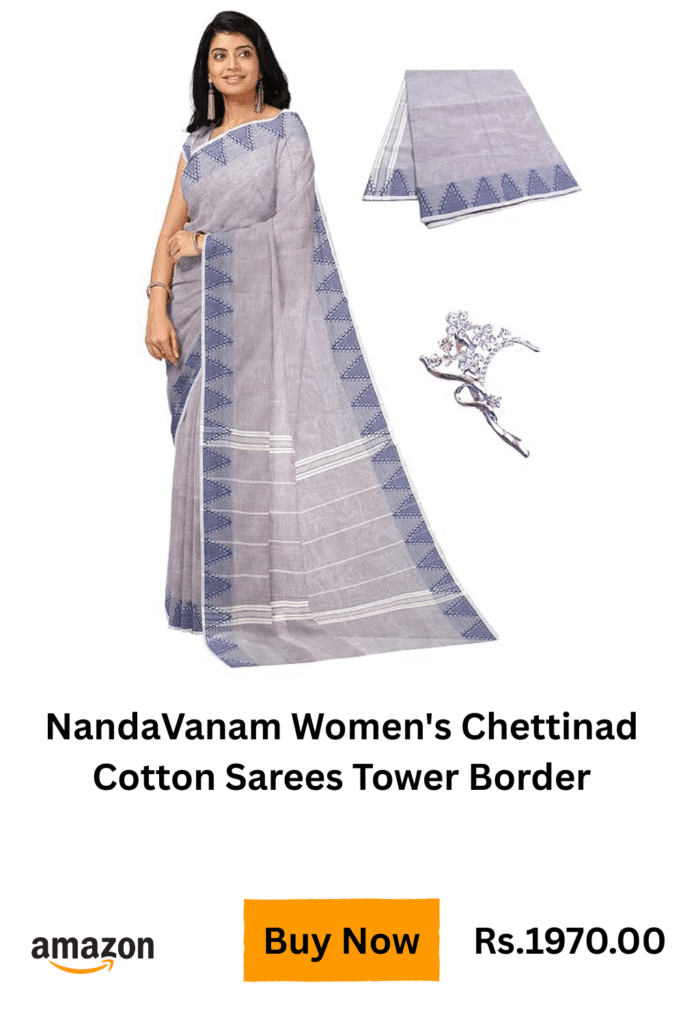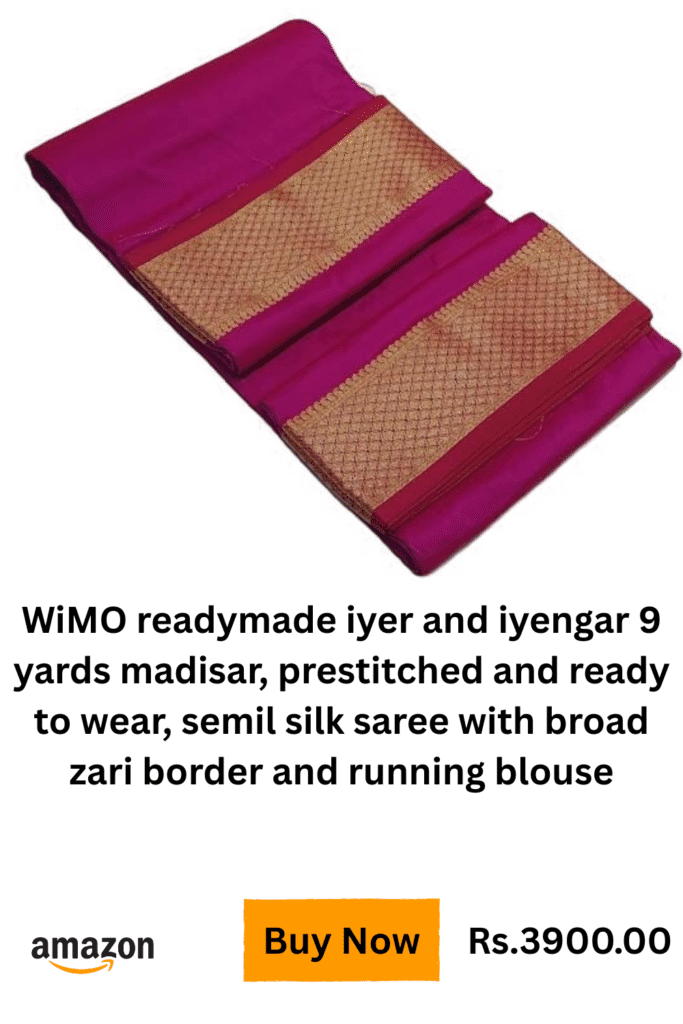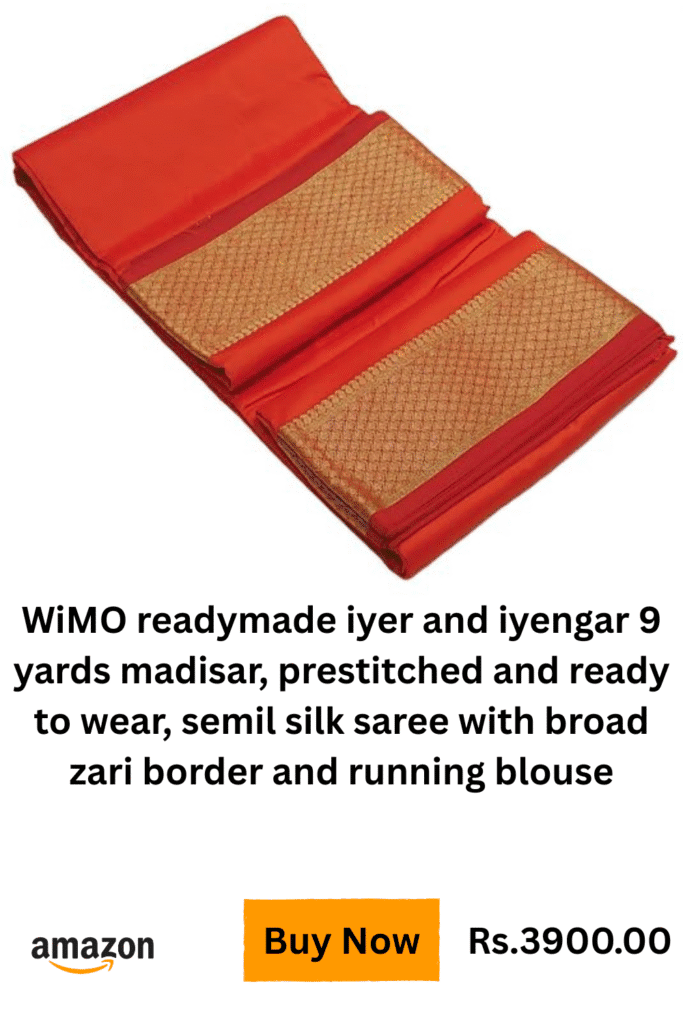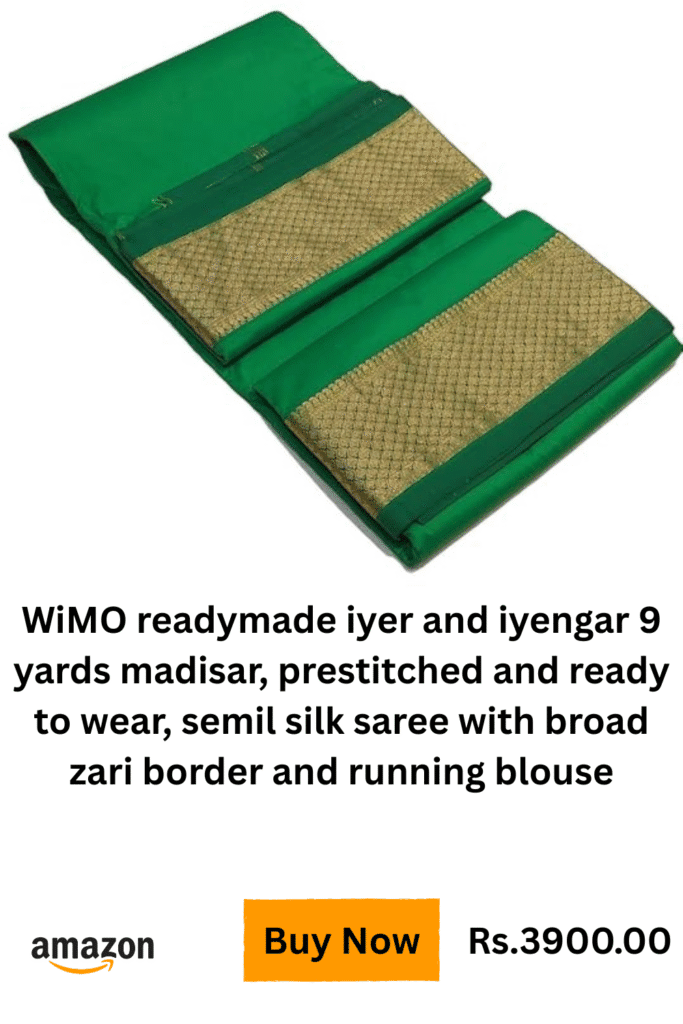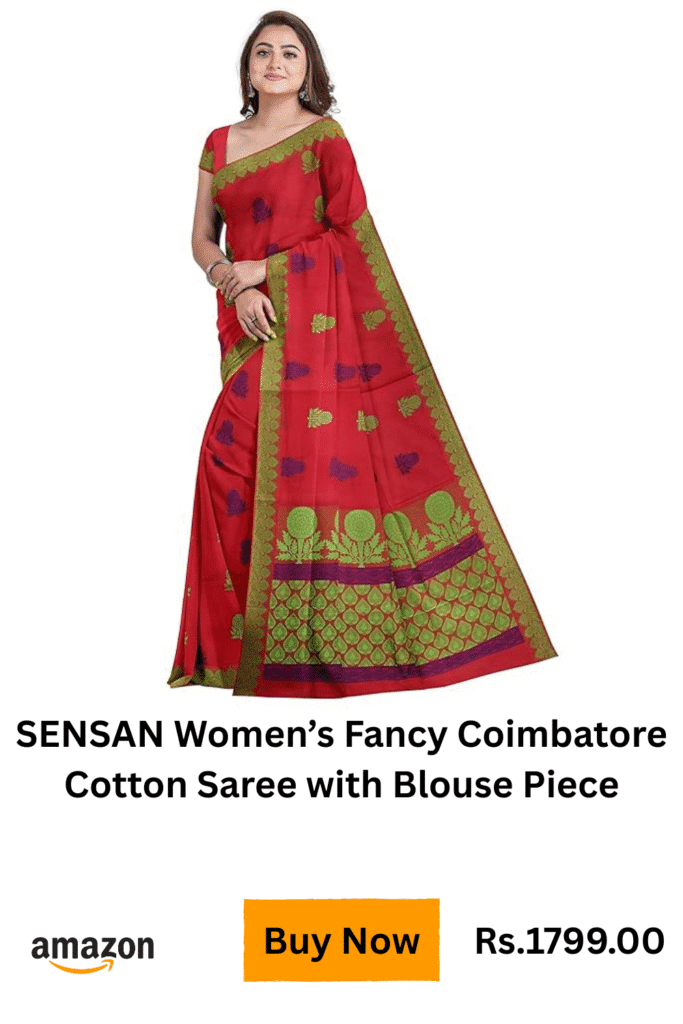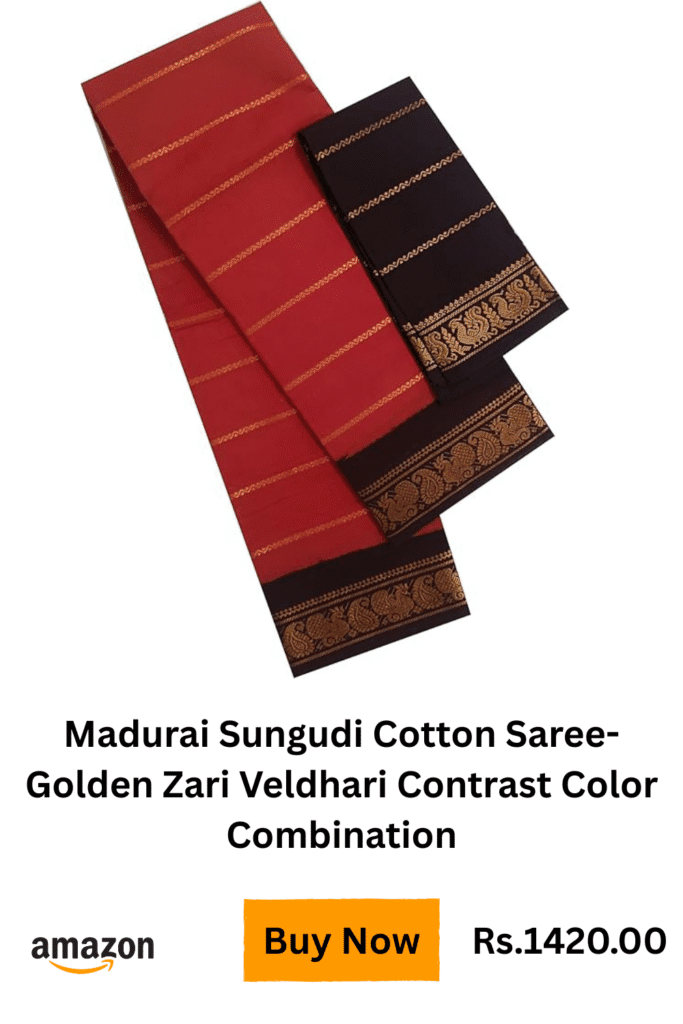Exploring the Traditional #1 Tamilnadu Saree Style Every Woman Should Know
Introduction
Personally, I think it’s really cool and unusual when people dress like that in today’s world. While much of the dreaded fast fashion is mass-produced, choosing to wear vintage-inspired pieces or actual vintage clothes shows a strong sense of originality and a taste for classics. It’s not just about the appearance; it’s also about the history, care, and eco-friendly nature of vintage clothing.
Have you ever found yourself in front of your closet, feeling puzzled by that beautiful Tamilnadu saree style? You might worry that you wouldn’t be able to wear it without looking like a doll. You’re not alone in that feeling.
The beauty of the six-yard South Indian saree isn’t just in the fabric; it’s in the centuries of culture woven into that one piece, which makes every woman look like a queen.
By the end of this guide, you will know how to wear the traditional Tamilnadu saree that both celebrities and everyday women have been wearing for generations. Say goodbye to endlessly looping YouTube videos.
This is what many people often get wrong about the Madisaru style, which can ruin your drape and make it appear fake instead of authentic.
The Rich Heritage of Tamilnadu Sarees

The Cultural Significance Behind Traditional Draping
- The Tamilnadu saree style isn’t just about draping fabric; it’s a cultural identity woven with tradition.
- Tamil women wear their sarees in a distinct way, with front pleats and a neatly tucked pallu over the left shoulder.
- This unique style reflects values of modesty, grace, and everyday practicality.
- Passed down through generations, the Tamilnadu saree style carries stories of heritage and pride in every fold.
Evolution of Tamilnadu Saree Styles Through Centuries
- The Tamil Nadu saree style originated many years ago with the basic cotton-hybrid wraps around the body and, today, the even luxurious silk creations.
- Early temple carvings display simpler iterations of the carvings with little to no draping, instead paying attention to ease and motion.
- The front pleats and more structured drapes emerged during the Chola period, making daily clothing more elegant.
- That bequest continues to shine nowadays as contemporary designers redesign the look of the Tamil Nadu saree to suit the runway.
Regional Variations Within the State
- Go to Tamil Nadu and you will see that the South style saree is not one size fits all, it dresses the body so well according to the region.
- Women on the Kongu area will have shorter pleats so that they can move easy when working on farms.
- Chetti women prefer more extravagant appearance and additional pleats which reveal abundance of their culture.
- The costal regions love the lighter materials and plain pallus which are very convenient and suitable to the lush air and how the style of the saree is changing in accordance to the style and weather.
How Tamilnadu Sarees Differ from Other South Indian Styles
- The saree style of tamilnadu is not mere draping it is a cultural representation, identity, and a replica of routine utilitarianism.
- With their different temples towns and coastal villages, the South style saree is so pretty, even as each has a story to tell.
- In Tamil Nadu, these pleats fall at the front in an orderly sense and the pallu covers the left shoulder in a very genteel and nonchalant manner.
- The Tamilnadu saree style is unique among the other south Indian drapes as it has bright colours, colored borders and rich and the meaning of the style is deeply rooted from the generations.
Essential Elements of the Traditional Tamilnadu Saree Look
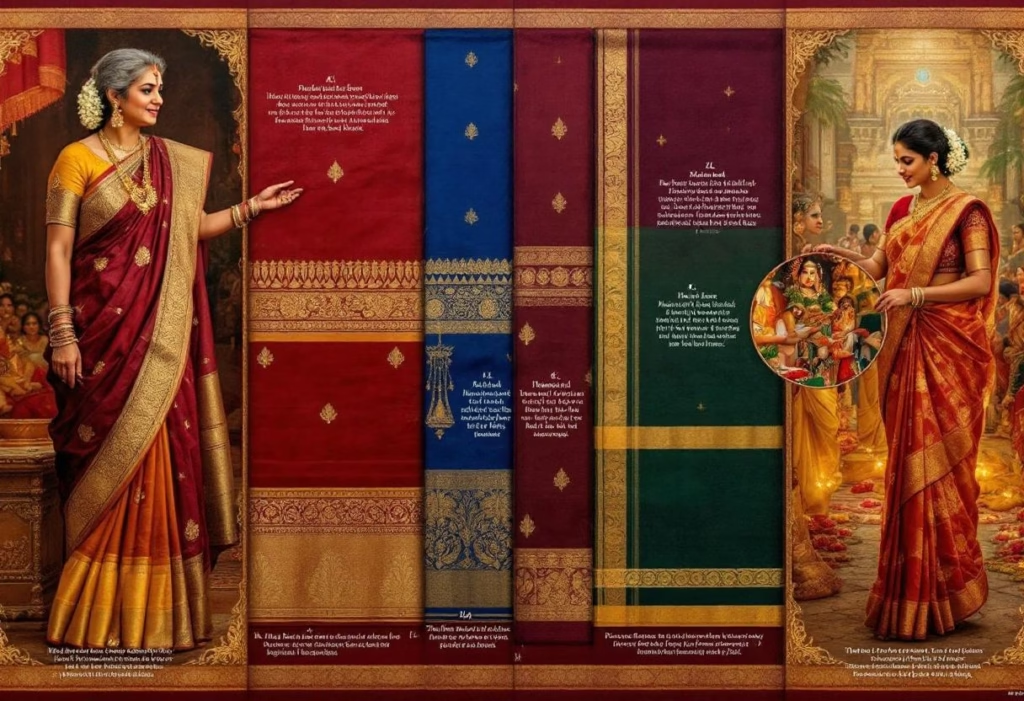
A. Signature Fabrics and Weaves to Recognize
- Kanchipuram silk is the gold medal tamilnadu saree style of the Kolam style, Tamilnadu. It is so luxurious and also durable, you can never see anything better than this.
- It is a true saree made in the South style with colourful clear contrast borders, separately woven and joined together a special detail you cannot ignore.
- Woven out of pure mulberry silk and pure gold, zari each Kanchipuram saree is a product of love and heritage.
- These are not clothes they are family heirlooms, with generations of stories sewed into every fiber, and likely to be so again, handed down to daughters as were their mothers.
B. Distinctive Color Combinations and Their Meanings
- The Tamilnadu saree style has its theme inside each color, deep maroons representing wealthiness, mustard yellows relating to a good start.
- Any South style saree can be characterized by the stark contrast between the body and the border of the saree, which is more than an aesthetical delight- it is a piece of cultural narrative spun in silk.
- Dark colors such as the peacock blue and the emerald green are usually used to mark fertility, happiness, and new beginnings particularly in weddings and festivals.
- While the bold colour palette seems more of a tradition, it is the classic way of Tamil people to express their identity adorably and to unite past and present generations in love.
C. Characteristic Border and Pallu Designs
- Tamilnadu saree style is beautiful due to the elaborated borders and the pallus which contain as many stories as the Tamil festival.
- A typical South style saree commonly has temple borders hinting at kovil (temple) architecture the veneration and art exhibited over a span of many centuries.
- Such designs as mayilkan (peacock eyes) or hamsa (swan motifs) are not just beautiful, but they also are symbolic, which makes them culturally important and elegant.
- That is the pallu where the magic happens, and there might be woven stories of epics such as Ramayana or Mahabharata, and your saree becomes a moving masterpiece.
D. The 9-Yard Wonder: Understanding the Madisaru
- All about tradition and grace, the Madisaru Tamils of the Tamilnadu saree style of is held, literally, all by hand, so there are no pins or pleats sewed in.
- Unlike most drapes, this South style saree drapes the nine-yard material around the body to provide natural trouser-like pleats, and it is suitable to move around during comings and goes of rituals.
- It is proudly represented by the Tamil Brahmin women who mostly wear it during weddings and religious processes.
- This classic cover is not only a fashion but rather a living tradition, the combination of spirituality, culture as well as womanhood in a single effect.
E. The Role of Zari Work and Embellishments
- What is a salient aspect about the Tamilnadu saree style is the use of the real gold zari (korvai), which is enhanced with age and this gives the drape a timeless value.
- Deep cultural narrative is achieved in each fold through temple-inspired images such as peacocks, mangoes, and traditional geometric patterns.
- The form of a saree today is a mixture of tradition and fashion, the combination of a slight stone work, delicate hand embroidery, light fabrics.
- The sarees are not just festive, they are art you can wear and which can help bridge the generations in an effortlessly-chic way.
Kanjeevaram Silk Saree
Different types of Tamilnadu Saree and its Fabric
| Saree Type | Origin/Region | Fabric | Key Features | Best For |
|---|---|---|---|---|
| Kanjivaram (Kanchipuram) | Kanchipuram | Pure Silk + Zari | Rich texture, contrast borders, intricate gold zari work | Weddings, festivals, grand events |
| Chettinad Cotton | Chettinad | Cotton | Bold colors, stripes/checks, thick woven borders | Daily wear, summer, traditional events |
| Madisar | Worn by Brahmin women | Silk or Cotton | 9 yards, unique drape forming pant-style pleats | Weddings, rituals, religious ceremonies |
| Kovai Cora Cotton | Coimbatore (Kovai) | Silk-Cotton Blend | Lightweight, bright hues, simple yet elegant | Office, semi-formal occasions |
| Thirubuvanam Silk | Thanjavur District | Pure Silk | Softer than Kanjivaram, subtle sheen, jacquard designs | Festive wear, temple visits |
| Sungudi Saree | Madurai | Cotton | Tie-dye dots, zari borders, vibrant shades | Summer wear, casual traditional wear |
| Rasipuram Saree | Rasipuram | Silk or Cotton | Checked patterns, temple borders, breathable fabric | Daily or festive, functional elegance |
Chettinad Cotton Saree
Step-by-Step Guide to Draping a Traditional Tamilnadu Saree
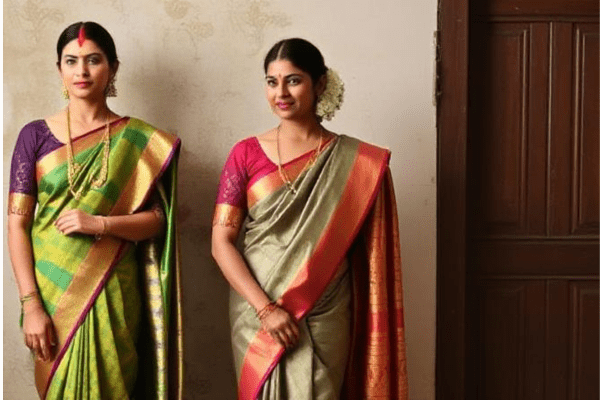
A. Preparing the Saree for the Perfect Drape
- To begin with, iron your saree on low heat pointer to get the wrinkles out of the material- this will make the fabric fall well.
- Find out which side is the pallu side (the most decorated end) and whether the inner side of the fabric is the one facing the centre or the outer side is facing the centre.
- Wear a tight fitting blouse and a petticoat with a well knotted petticoat that should suit your Tamilnadu saree style or complement the colour of your saree.
- Grab some safety pins by your side, they will come handy in keeping everything in place as you go through the draping processes with confidence.
B. Achieving the Classic Madisar Style
- Begin by tucking one side of the saree under at waist level and draw the material between legs making natural pleats without using any pins.
- Repeat the same process by wrapping the length around your waist but this time make sure that the folds are precise and not bulky so that you can walk comfortably with the length around your waist.
- Create a pair of pleats in the front, even that out so it rests and feels comfortable without feeling heavy.
- Just hang the loose end over your left shoulder and then let it drop with grace maintaining everything down right and tight.
C. The Modern 6-Yard Adaptation for Everyday Wear
- To start with your Tamilnadu saree style, tuck the plain end of saree around right waist and hold it such that it does not slip away.
- Fold the front in neat pleats, as many as 5 or 7 an inch or so across; fasten the pleats in at your navel.
- Take the remainder of the cloth and fold it around your body to bring it up over the front with soft clean folds.
- Lastly, tie the pallu on the left shoulder and have it hang loose yourself on the back of your body to create that elegant touch.
D. Common Draping Mistakes to Avoid
- Ensure your petticoat is off well tied- when it is too loose your saree will keep falling the entire day.
- Pick your pleats, you do not want your drape to seem heavy and disorganized.
- Spread the pallu correct way so that the gorgeous border or design does not get covered or obscured-let it shine!
- When to wear Tamilnadu saree style do not wear excessive safety pins, they make you look cluttered, ensure that you wear just the right amount so that you do not have to pin all day long. As they say practice makes perfect.
Madisar Silk Saree
Accessorizing Your Tamilnadu Saree Look
Traditional Temple Jewellery That Completes the Look
- The Tamilnadu saree style is incomplete without the gleam of traditional temple jewellery– Goddess patterns and huge gold pattern can be mixed up here.
- Kemp stone choker going with silk saree will give immediate royal touch which has been based upon centuries old craftsmanship of Tamil.
- Swinging jhumkas, stacked bangles and waist bands are enough to boost your overall appearance dotted with rich culture and finesse.
- Each design is a folktale- you cannot wear temple jewellery to supplement your saree, but rather, to show once again that Tamil is beautiful with the powers of grace.
The Significance of the Pottu (Bindi) and Its Placement
- This small red dot between the eyebrows is not just a fashion detail, this is concentration, wisdom, spiritual harmony.
- In Tamil tradition, bright red kumkum pottu may be an indication of marital status and some of the women may put a dot of black color under the red-colored kumkum pottu for a safety reason.
- The trick is where you place it: and it should be just between the brows no higher (alarmed) or lower (menacing).
- Once the complete traditional Tamilnadu saree style is made, it is the finishing, which is the defining point of the traditional representation with that one little strong line.
Hair Styling and Flower Adornments
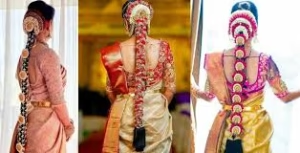
- The Tamil women learn the art of how to make the right kondai, which is a neatly kept low bun.
- Bound in the bunches of fresh jasmine (mullai) it is beyond beautiful and the aroma relaxes the mind and keeps you cool during the day.
- The conventional veni style, in which flowers are cascaded on one side, is a statement of poetry, culture in a straightforward hairstyle.
- Tradition is one thing but it is also the grace that is inherited through generations. And of course your grandmother would give the stamp of approval.
Footwear and Other Complementary Accessories
- Put on a pair of gold kolhapuris or embroidered juttis, both of it is easy on the feet rich in the traditions.
- A small silk potli bag or an old style clutch that is decorated with zari or mirror work will also have your essentials at hand neatly.
- Complete your silhouette with the inclusion of a fine waist chain (oddiyanam) and crown the saree drape with a royal touch.
- I do not see these little accessories as accessories, but as subtle, almost unnoticeable references to Tamil beauty that completes the entire Tamilnadu saree style look so perfectly.
Kovai Cotton Saree
Modern Interpretations of the Tamilnadu Saree Style
Contemporary Designers Reimagining Traditional Patterns
- The Tamilnadu saree style has had a glow up nowadays, we no longer stick it only to rituals or temples.
- Today designers are recreating the Tamilnadu saree with bold colors along with bold borders and bold blouse cuts.
- Imagine electric blues, gold zari or half-and-half drapes which would give a traditional touch but in striking, modern glamour.
- It is all about keeping the tradition and making every step a fashion statement generation z style, grandma approved.
Fusion Styles for the Modern Woman
- You do not have to choose between following a trend and being traditional because you can own both.
- Today, the modern saree designs have heritage combined with fresh exuberance, and are just right to be adopted by the woman who heats everything.
- Wear a vintage silk curtain with a crop top, tie a belt around the waist, or put on a metallic jacket to get attention.
- This fusion style can be worn to office, evening cocktails, formal meetings, or even to a casual hangout with your friends. All you need is to change the accessory and you are good to go.
Adapting Traditional Styles for Different Body Types
- The charms of the correct drape of the Tamilnadu saree style? it does not conflict against your body but rather functions in your favor.
- Petite on the other hand should choose narrow borders and thin prints to maintain a balance.
- With bit more curves, the shapes are beautiful and the waist is naturally pinched and defined with pleats.
- Taller females are free to wear such a full-length drape to the full-length-it is dramatic just in the right manner.
Sustainable and Ethical Choices in Tamilnadu Sarees
- The saree world is not only interested in looking good but it is becoming smarter.
- Nature-sensitive patterns The eco-friendly Tamilnadu saree styles are no longer made of artificial dyes; hand-woven cloths and eco-friendly production.
- Buyers are moving to meaningful fashion that is bringing local artisans and weaving communities into the limelight.
- These eco-friendly sarees are not only trendy, but they are heartwarming as they preserve age-old culture and maintain our respect towards earth.
Sungudi Cotton Saree
Occasions and Celebrations for Tamilnadu Saree Styles
A. Wedding and Bridal Traditions
- Tamil brides really are like deep, glowing velvet-dyed silks–usually of deep red colour or maroon, and carefully wove in goldwork.
- Their sarees are worn in a conventional manner which is a talk of heritage, generations of blessings, prosperity and feminine power.
- Any bridal look will be incomplete without necklace brackets of antique gold jewellery with layers of stories behind them.
- And what is to crown it? Fresh jasmine on her head, strings of it which knotted together beauty and tradition in a single, unforgettable hair style.
B. Festival-Specific Saree Styles
- Festivals in Tamil culture are not only celebrated but they are carried. Pongal is a time of the year when women would prefer to wear earthy sarees in mustard color, and in green color, or deep red that has the traditional sign of peacock or temple decoration.
- Once Diwali comes, it is all about glitz- glittering silk sarees decorated with the amount of glitter that suits the bursts that are on display.
- There is lovely rhythm of colour as the women will go in sarees, which follow the traditional color of the day.
- Even now people would still perform the traditional drape during such events and every celebration would be regarded like a living heritage to the past.
C. Everyday Elegance: Incorporating Traditional Elements in Daily Wear
- Why do you have to be in a festival to wear something classic? Tamilnadu saree style also suits perfectly well in the ordinary life.
- Cotton sarees with fine temple borders are ideal to wear and feel comfortable, breathable and full of reserved beauty.
- The working girls tend to take cotton-silk blends with a minor amount of zari- easy to handle and at the same time traditional.
- Combined with modest curtains and minimalistic jewellery, these sarees will show you that respecting the traditions does not imply giving up modern comfort.
D. Formal and Professional Settings for the Traditional Look
- Tamil sarees are not only celebration based they also mean business.
- I am thinking of Kanjivarams in light tones or silk-cotton combinations with minimal sparkle to them-They know how to get you any spotlight you desire without uttering a single word.
- The classic style nivi drape adds organize and charisma to look good during a meeting or a presentation.
- That is how you can flaunt your culture even as you rise up the corporate ladder.
Conclusion
The traditional Tamilnadu saree style is a very beautiful combination of the cultural heritage and eternal elegance which has been developed over the centuries. Since learning the glorious history of these magnificent textiles, the distinctive way in which they can be draped and much more we have been learning how even in the modern day, these sarees are still relevant in fashion. The traditional accessories are used along with the perfect pleats and the typical border patterns, to form an appropriate and regal yet uniquely South Indian outlook to the perfect choli.
Getting ready to a wedding or festival, or just making an attempt to get closer to the roots of your culture, the Tamilnadu saree will suit you and will make you feel free and stylish. Adopting a centuries-old technique and introducing the modern interpretations to it, you may wear this draping style and pay respect to an old tradition and reveal your unique style. We do invite you to experiment with this beautiful way of draping and feel the culture and beauty which has made Tamilnadu s aree a permanent mark of South Indian female beauty and elegance.
Curious about to know state-wise traditional dresses? Please click here.
FAQs
What is special about the Tamilnadu saree style?
Tamilnadu saree style is all about heritage and grace. From the rich Kanchipuram silks to the airy Madurai Sungudi cottons, each saree tells a cultural story. The drapes, fabrics, and motifs vary across regions, reflecting the deep-rooted traditions and craftsmanship unique to Tamil Nadu.
Which saree is most popular in Tamilnadu?
The Kanchipuram silk saree is the most iconic in the Tamilnadu saree family. Known for its rich zari borders, temple motifs, and durability, it’s a must-have for weddings and festive occasions. These sarees are woven from pure mulberry silk and are prized for their elegance.
Are there different draping styles in Tamilnadu saree tradition?
Yes! One of the most distinct Tamilnadu saree styles is the Madisar drape, traditionally worn by Tamil Brahmin women. It’s a nine-yard saree draped in a unique way that symbolizes tradition and spiritual grace, often seen at weddings and religious ceremonies.
Can I wear Tamilnadu saree casually?
Absolutely! Styles like Kandangi and Sungudi cotton sarees from Tamilnadu are perfect for casual or everyday wear. They’re breathable, vibrant, and easy to carry—making Tamilnadu saree style versatile enough for both daily elegance and cultural celebrations.


